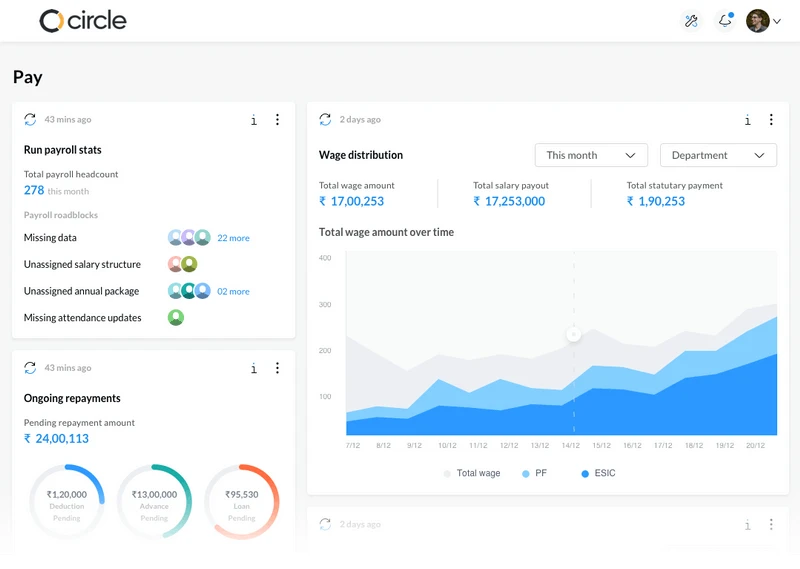Employee benefits are compensation for employees besides base wages or salaries. Human resource management mentions benefits, including health insurance, retirement plans, life insurance coverage, disability income protection, vacation time, sick leave, flexible spending accounts for healthcare and dependent care expenses, employee assistance programs (EAPs), tuition reimbursement, and other perks in the employment letter. Around 57% of small firms increase employee salaries in a year.
1. Overview of HR Budgets
HR roles and responsibilities offer the necessary resources to implement and maintain a comprehensive compensation package that meets the needs of both employers and employees. An HR budget should include funds for health insurance, retirement plans, leave policies, educational assistance programs, and other financial incentives such as bonuses or stock options. Balancing the costs of these programs while still providing competitive wages is critical to staying within budget and ensuring adequate compensation for workers.
Additionally, it is essential to ensure that employee benefits are structured to meet organizational goals while promoting employee satisfaction and engagement. By carefully planning their HR budgets, employers can get the most out of their benefits packages without overspending.
HR budgets can provide insights into an organization’s priorities and values. For example, a higher budget allocation towards employee compensation and benefits may indicate that the organization strongly emphasizes employee satisfaction and retention. Similarly, a higher budget allocation towards training and development may suggest that the organization is committed to developing its employees and promoting their professional growth. Moreover, the COVID-19 pandemic has impacted HR software budgets, forcing organizations to adapt and reallocate their resources to support remote work and employee safety measures.
2. Current State of Employee Benefits
Employee satisfaction, employee compensation, and career development are all critical factors in today’s corporate environment regarding employee benefits. Companies must provide their employees with adequate compensation packages recognizing their dedication, hard work, and benefits such as retirement savings and health plan options.
Employee satisfaction must also remain a priority, so employers should focus on creating workplace policies and cultures of appreciation.
Finally, employers must understand the importance of ongoing career development to ensure their employees’ skill sets remain relevant in industry advancements.
3. Impact of Budget Cuts on Employee Benefits
Budget cuts can significantly impact employee benefits, most notably in the recruitment process, training costs, and turnover rate. Training costs may be reduced when budget constraints require tighter spending, and staff may not receive the training required for their roles or career development.
Finally, budget cuts can increase turnover as more employees look for better opportunities elsewhere due to constrained compensation and benefits packages. These impacts can create a problematic situation for organizations facing budget cuts due to market forces or other external factors. According to a Gartner survey conducted in 2021, 68% of HR leaders have stated their intention to develop employees’ essential skills and competencies in the upcoming year.
4. Strategies for Managing Employee Benefits Within HR Budgets
Managing employee benefits within HR budgets can be challenging since most companies want to maximize their return on investment. Therefore, it is essential to carefully assess which benefits programs best fit a business based on employee needs and administrative costs. Companies should also look into digital transformation to improve the efficiency and cost savings associated with managing employee benefits. Additionally, companies should consult industry benchmarks when considering different types of benefit packages to stay competitive, especially during tight budget periods.
Workforce engagement and communication are crucial for managing employee benefits within HR software in India budgets. Companies should ensure employees understand their benefits packages and have the tools to take advantage of them. Employers should also develop a company culture of appreciation and reward to ensure employees feel valued and remain motivated to contribute to organizational success.
The following are a few strategies and recommendations to manage optimum employee benefits and your budget.
- Cost-Effective Solutions for Providing Employee Benefits Within HR Budgets
One of the most cost-effective solutions for offering employee benefits within HR budgets is utilizing a mix of self-insured and traditional group insurance plans. By creating a hybridized approach, companies can make efficient use of the resources available in each solution, accessing additional funding sources if necessary without straining current spending on employee benefits.
Other cost-effective measures include offering voluntary or supplemental benefits such as dental, life, and disability insurance and using an online platform to manage decisions related to healthcare spending accounts.
Finally, employers should consider value-based pricing models offering better coverage at a lower overall rate. Compensation plans should also be reviewed regularly to ensure the organization provides competitive wages and benefits for its positions.
- Long-Term Planning and Budgeting Strategy to Manage Employee Benefits
Managers should create a career path for current employees as part of an effective long-term planning and budgeting strategy to manage employee benefits. It will allow employees to set goals and progress within a company over time. When budgeting for employee benefits, managers should consider both short and long-term costs and plan accordingly over some time. Moreover, allowing employees to see potential career paths can help them decide about their future in the company and how they can benefit from various employee benefits.
These strategies should be implemented for consistency so that all employees can enjoy similar advantages throughout their employment at the company. Medium and large organizations typically allocate a percentage of their salary budgets, ranging from 2 to 5%, towards investing in training. It communicates to the employees that their learning, upskilling, and industrial competitiveness are valued at the company.
- Monitoring and Evaluating the Effectiveness of Benefit Programs
Monitoring and evaluating the effectiveness of benefit programs is essential for budgeting processes, recruiting managers, and workforce planning. Through thorough analysis of employee benefit costs and strategies, employers can develop an efficient set of benefits packages that meet the needs of their employees while staying within their budget limits. Monitoring and evaluation efforts also help ensure that measures are taken to reduce, minimize, or eliminate discrepancies between actual results achieved versus desired outcomes.
Additionally, monitoring and evaluation allow companies to understand why certain benefits are necessary to retain key employees through accurate assessment and measurement of benefits-package effectiveness. By leveraging various data sources such as surveys, interviews, and focus groups, employers can gain insight into how a company’s overall workforce strategy is impacted by its benefit programs.
5. Wrapping Up
Employee benefits significantly attract, retain, and engage employees, ultimately impacting the organization’s bottom line. However, providing employee benefits can be costly, and organizations must carefully manage their HR budgets to allocate resources effectively. Additionally, employers should create a career path for employees to provide them with long-term benefits and opportunities for growth.
Furthermore, companies should monitor and evaluate the effectiveness of their benefit programs to ensure they are meeting the needs of their employees. By taking these steps, employers can effectively manage employee benefits while staying within budget limits.
At sumHR, our goal is to amplify the effectiveness of HR teams worldwide. We have designed a comprehensive cloud-based HR platform, providing a configurable, adjustable HRMS to enable HR personnel to automate tedious tasks, cut through confusion, and increase employee satisfaction with their HR experience. We firmly hold that Human Resources is the cornerstone of any business.








